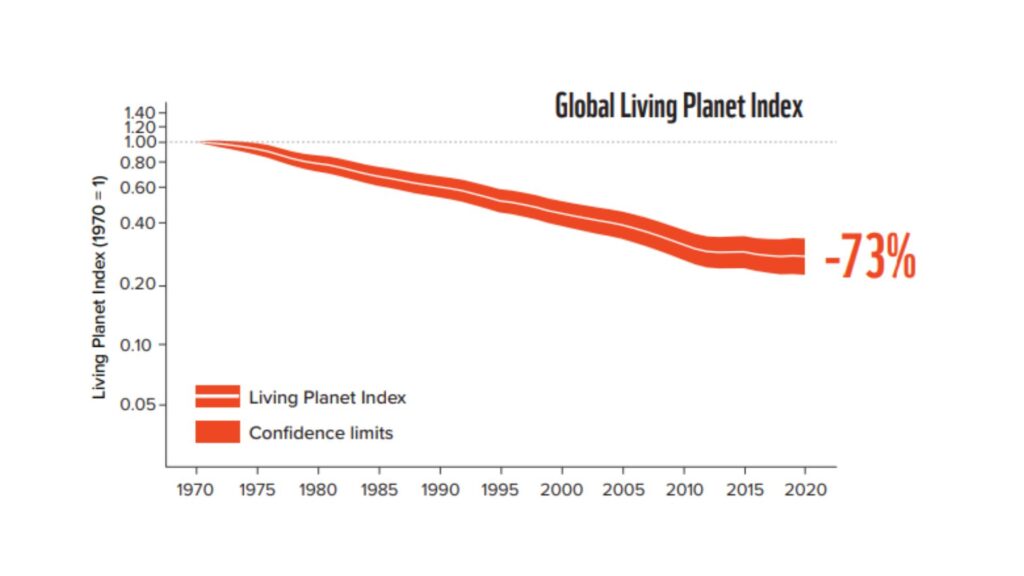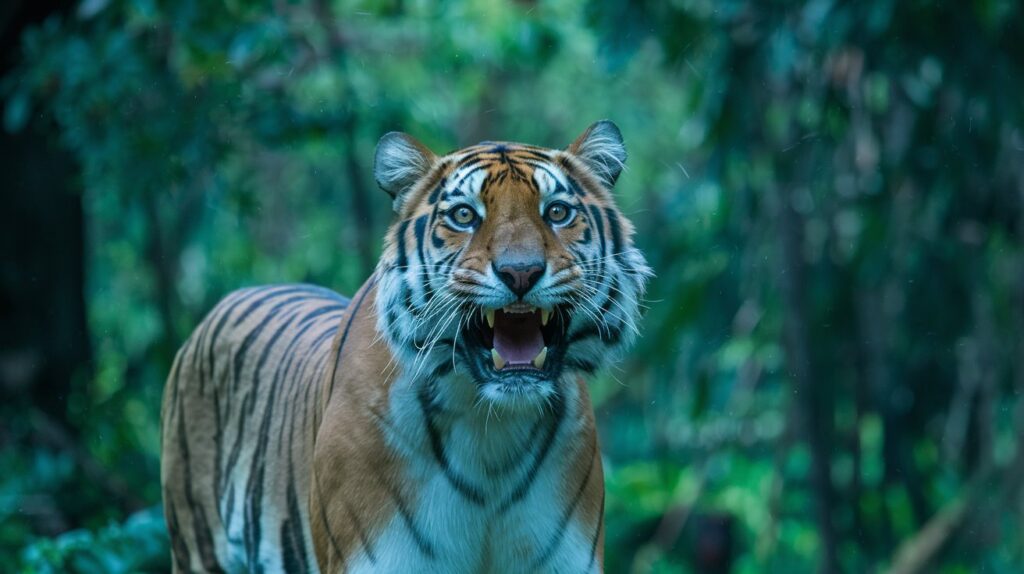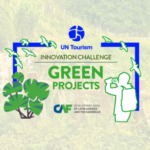WWF’s flagship Living Planet Report details sharp declines in monitored wildlife populations with the steepest drops recorded in Latin America and the Caribbean (95%), Africa (76%) and Asia–Pacific (60%), followed by North America (39%) and Europe and Central Asia (35%).
The latest report from the World Wildlife Fund (WWF) has brought alarming news to the forefront: wildlife populations worldwide have suffered an unprecedented 73% decline in just 50 years. This revelation is more than just a statistic—it is a wake-up call that underscores the fragility of our natural ecosystems and the impact of human activities on biodiversity. Over the past 50 years (1970–2020), the average size of monitored wildlife populations has shrunk by 73%, as measured by the Living Planet Index (LPI). This is based on almost 35,000 population trends and 5,495 species of amphibians, birds, fish, mammals and reptiles. Freshwater populations have suffered the heaviest declines, falling by 85%, followed by terrestrial (69%) and marine populations (56%).
The Living Planet Report, a detailed analysis of global wildlife trends, exposes how habitat loss, climate change, overexploitation, pollution, and invasive species are driving the decline of species essential to our planet’s health. Without immediate action, we risk crossing irreversible ecological thresholds, with dire consequences for wildlife and humanity.
Declines in wildlife populations can act as early warning indicators of
increasing extinction risk and the potential loss of healthy ecosystems.

When ecosystems lose resilience they are more susceptible to additional disturbance and the report examines how the dual crises of nature loss and climate change are pushing the planet closer to dangerous and irreversible tipping points. The Living Planet Report underlines the urgency of the world meeting global goals on nature, climate and sustainable development by 2030. To achieve this, it presents solutions to transform conservation and the energy, food and financial systems in a fair and inclusive way. The report warns that the next five years will be crucial for the future of life on Earth but that there is hope.
The Alarming State of Wildlife Decline
According to the WWF’s findings, the decline in wildlife populations is not evenly distributed across regions or species. Some areas, particularly those rich in biodiversity like the Amazon rainforest and African savannahs, are experiencing even more severe reductions. For instance, freshwater species have declined by an average of 83%, the most significant drop across any species category.
WWF attributes these losses primarily to the following factors:
- Habitat Destruction: Deforestation, agricultural expansion, urban development, and mining activities are decimating natural habitats. As forests and wetlands are cleared to make way for human activities, countless species lose their homes and food sources, leading to population declines.
- Climate Change: Rising global temperatures and changing weather patterns disrupt ecosystems, altering migration patterns, breeding cycles, and food availability for wildlife. Polar regions and coral reefs are particularly vulnerable, with species like polar bears and coral-dependent fish facing existential threats.
- Overexploitation: Overfishing, hunting, and illegal wildlife trade are pushing species toward extinction. Unsustainable fishing practices have depleted fish stocks and disrupted marine ecosystems. Land-based species like tigers and rhinos are hunted for their body parts, fueling the illegal wildlife trade.
- Pollution: Chemical runoff from agriculture, plastic pollution, and industrial waste continue to contaminate land and water ecosystems. Marine life, in particular, suffers greatly from plastic debris, which can entangle species or be ingested, leading to fatal consequences.
- Invasive Species: Non-native species introduced into new environments can outcompete, prey on, or bring diseases to native species, further destabilizing local ecosystems.
The Ripple Effect: Why Wildlife Decline Matters to Us All
Wildlife plays an integral role in maintaining ecosystem balance. The sharp decline in biodiversity directly affects ecosystem services that humans rely on, such as pollination, water purification, climate regulation, and soil fertility. The loss of these services can lead to food and water insecurity, increased natural disasters, and economic instability.
Pollinators, such as bees, birds, and bats, are essential for agricultural productivity. Their decline threatens global food supplies and the agricultural economy. Similarly, wetlands and forests act as natural carbon sinks, absorbing greenhouse gases from the atmosphere. As these ecosystems degrade, our ability to combat climate change diminishes, exacerbating global warming and its associated impacts.
Economic Implications: Nature’s Positive Value Beyond Measure
The financial cost of losing wildlife and degrading ecosystems is immense. According to WWF and other environmental economists, the global economy could suffer trillions of dollars in losses annually if current trends continue. Natural resources provide livelihoods for millions of people, especially in developing countries where eco-tourism, fisheries, and agriculture are primary sources of income.
The degradation of ecosystems threatens these economies, leading to job losses, increased poverty rates, and greater social inequalities. Investing in nature conservation is not just about protecting wildlife; it’s about sustaining a healthy economy, ensuring food security, and building resilience against climate-related risks.
A Call to Action: What Needs to Be Done
Addressing the wildlife crisis requires urgent, collective action at all levels of society. WWF’s report outlines several key strategies for reversing the decline:
- Strengthening Global Conservation Efforts: Governments and international organizations must prioritize expanding protected areas, implement stricter anti-poaching laws, and crack down on illegal wildlife trade. Collaborative efforts between nations can amplify the impact of conservation initiatives.
- Transitioning to Sustainable Practices: Industries that rely heavily on natural resources, such as agriculture, forestry, and fisheries, must adopt sustainable practices. This includes reducing deforestation, eliminating overfishing, and promoting eco-friendly farming techniques that minimize environmental impact.
- Mitigating Climate Change: Drastic reductions in carbon emissions are essential to slow the pace of global warming. Investment in renewable energy sources, reforestation, and restoration of degraded lands can help mitigate climate impacts and provide habitats for wildlife.
- Promoting Biodiversity-Friendly Policies: Policymakers should incentivize conservation actions within the private sector. Supporting businesses prioritizing sustainability, reducing subsidies for environmentally damaging industries, and promoting green innovation are key to driving systemic change.
- Public Awareness and Education: Raising awareness about the importance of biodiversity is crucial in mobilizing grassroots efforts. Educational campaigns that emphasize how individual actions—such as reducing plastic use, supporting sustainable brands, and protecting local wildlife—can collectively make a significant difference.
Green Initiative’s Perspective: Regenerative Tourism as a Solution
In alignment with WWF’s call for integrated solutions to the wildlife crisis, Green Initiative, a leader in sustainable development, emphasizes the role of regenerative tourism in transforming how we interact with nature. His upcoming white paper outlines six dimensions of regenerative tourism: Community Engagement, Biodiversity, Climate, Water, Landscapes, and Governance.
Regenerative tourism aims to enhance environmental conservation and promote economic development by fostering deeper connections between travelers and local communities. This approach minimizes tourism’s impact on natural habitats and actively contributes to the restoration and preservation of wildlife ecosystems.
The Role of Individuals in Wildlife Conservation
While large-scale policies and international cooperation are critical, individual actions can also make a meaningful impact. Here are some ways that each of us can contribute to the cause:
- Support Sustainable Brands: Choose products from companies that prioritize environmental responsibility, use eco-friendly materials, and have transparent supply chains.
- Reduce Carbon Footprint: Minimize personal energy use by adopting renewable energy sources, reducing travel emissions, and conserving water and electricity.
- Protect Local Wildlife: Participate in or donate to wildlife conservation programs in your area, support habitat restoration projects, and engage in community clean-ups.
- Advocate for Policy Change: Use your voice to advocate for stronger environmental protection policies, support local conservation initiatives, and hold corporations accountable for their environmental practices.
A Path Forward: Hope Amidst the Crisis
Despite the grim statistics, there is still hope. Nature’s resilience means that with dedicated efforts, many ecosystems and species can recover. Success stories of species brought back from the brink of extinction demonstrate that change is possible when humanity unites for a common cause.
The WWF’s report serves as both a warning and a guide, highlighting the need for immediate, coordinated action to halt wildlife decline and restore nature’s balance. We can steer the planet toward a more resilient and prosperous future by embracing sustainable practices, investing in conservation, and prioritizing biodiversity in policy and business decisions.
Conclusion
The unprecedented decline in global wildlife populations is not just a crisis for nature; it’s a crisis for humanity. Our future depends on the health of the planet’s ecosystems. As we stand on the brink of a tipping point, our actions today will determine the legacy we leave for future generations.
Now is the time for global leaders, industries, and individuals to act decisively and collaboratively. It’s still possible to make a difference, but the window of opportunity is closing rapidly. Together, we can protect the planet’s biodiversity, secure our future, and create a world where people and nature thrive.
For more in-depth insights, visit the WWF’s official press release here. Download the full Living Planet Report 2024, executive summary, and media summary here.
Green Initiative supports businesses and communities in reducing their environmental impact and boosting positive effects on nature. This includes helping measure and lower their carbon emissions, protect local wildlife and ecosystems, and create more sustainable ways of operating. Through hands-on advice and practical solutions, we encourage organizations to go beyond just reducing harm, aiming to make a net-climate and nature positive contribution to the environment. Contact us to learn more.
Written by Yves Hemelryck from the Green Initiative Team.






